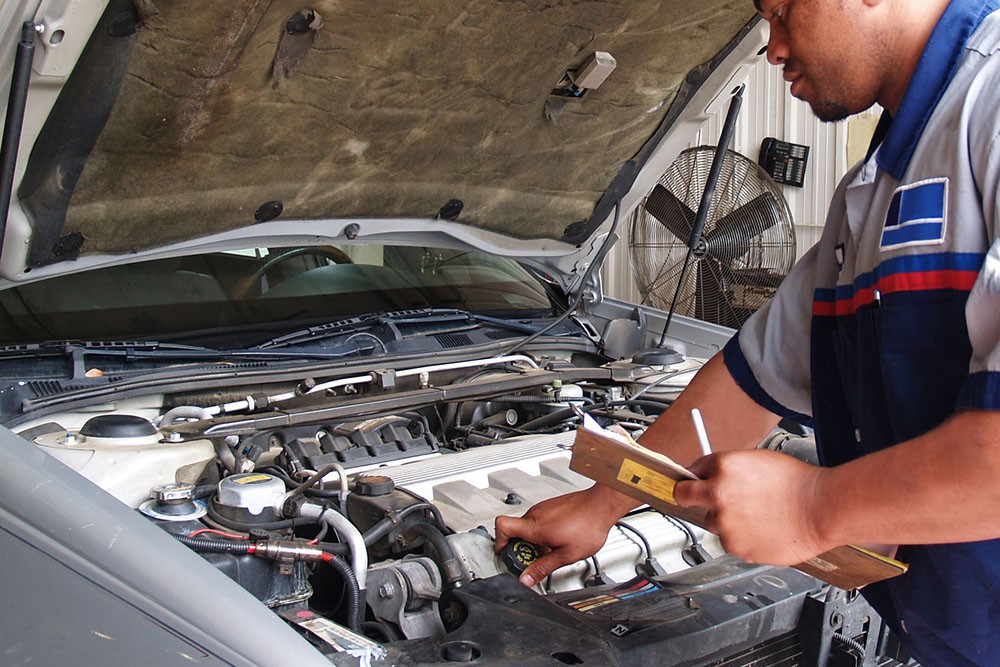
There’s nothing like a good spring cleaning for your house, so why not plan a spring cleaning for your car? And since it’s National Car Care Month, it is the perfect time to show your car you care.
This last winter has taken its toll on vehicles traveling on snow and ice and splashing through torrential downpours. Or maybe, your car sat quiet throughout winter and is ready for a tune up before it hits the road. Either way, it’s time to give your car the attention that it needs with these springtime vehicle inspection must do’s below:
Springtime Vehicle Inspection Must-do’s
- Test your battery. Changes in temperature tend to trigger battery problems. Particularly cold temperatures can drain your car’s battery. Have your battery tested by a professional to ensure it's in good condition. Listen to your vehicle when it starts in the morning. Does it struggle to turn over? This might be a sign your battery is about to die.
- Check for proper tire inflation, plus wear and tear. After the winter season, it's important to check the condition of your tires. Look for signs of wear and tear, damage, or uneven tread wear. Also, check the tire pressure and make sure it's within the recommended range. Tires lose up to 3 PSI per month. Don’t forget to inspect your spare tire as well.
- Pump the brakes. Winter can be hard on your brakes, so make sure they are in good condition. If you notice your brake pedal goes all the way to the floor, or if the brake system isn’t responding promptly, there could be a leak in brake lines. Check the brake pads, rotors, and brake fluid levels as well.
- Replace engine and cabin air filters. Clogged engine air filters can reduce proper air flow to the engine causing your car to work harder. A clean cabin air filter improves the interior health of your cabin and reduces allergens.
- Inspect car hoses and belts. Cold winter temperatures can lead to cracks in engine hoses and belts. Cracks in hoses can turn into major leaks come warmer days. And squealing belts or cracked belts can hinder your engine from running properly.
- Inspect your wiper blades. Check your wiper blades to ensure they are working properly. Worn out wipers can smear spring grime, reduce visibility and scratch your vehicle windows. Don’t be caught in a spring rainstorm without good wiper blades.
- Top off fluids. Spring is a good time to check all your car's fluid levels, including engine oil, coolant, transmission fluid, power steering fluid and brake fluid. Top off any fluids that are low.
- Check the ventilation and A/C system. Having your internal cooling system working properly is critical for the warmer months. Clear air vents under the hood of any leaves or debris which could impair airflow. Flowing air may improve engine performance and is important for interior climate control and comfort such as defogging and air conditioning.
- Repair damaged headlights. Ask your service advisor about repairing damaged headlights to improve brightness for night driving. Perform a vehicle walk-around to check for blown out and dull bulbs. Replacing bulbs is an inexpensive safety service that is fast and easy to do. Yellowed headlamp lenses reduce visibility and may be restored rather than replaced.
- Fix a cracked windshield. The harsh winter weather can kick up a lot of debris, especially as things begin to melt. If you have a crack in your windshield, it’s best to attend to it immediately as warmer weather can cause chips to spread into vertical cracks. A small chip or crack can turn into a lengthy, lightning-shaped crack requiring an expensive window replacement.
Other car care tips for the beginning of spring
Part of taking care of your car is keeping it clean, both inside and out.
- Keep your car clean. While it’s always a good idea to keep your car clean, no matter what time of year, the winter can leave your car particularly dirty. A proper wash to remove the leftover winter grime is critical. Clean the undercarriage as well, as this is typically where most of the salt and grime accumulates.
- Put life back into your vehicle’s paint. Winter conditions can strip the wax from painted surfaces. So, after a good car wash, give your vehicle special treatment and follow up with quality wax to protect it throughout spring.
- Improve your springtime visibility and reduce glare. Grit and grime can cloud the exterior window surfaces and haze tends to build up on inside surfaces. Use window cleaner designed for vehicles.
- Dirty floor mats and carpet. Clean all carpet surfaces to eliminate odor, allergens and mold. Also, consider getting a set of rubberized mats to prevent dirty shoes and spills from reaching carpeted flooring. Consider rubberized mats as they are easier to clean–especially important if you plan spring hikes and pet adventures.
- Remove grime from wheels. Road salts, winter sludge and dirty rain water mixed together can tarnish your vehicle’s beautiful alloy or chrome wheels. Left unattended to, the grime can create stains and pits. Use a cleaner designed specifically for vehicle wheels to get that shine back.
- Keep a couple of microfiber towels in your car. Purchase a bag of microfiber towels to leave in your car. They are inexpensive and are great for cleaning and soaking up spills.
- Deep cleaning of car’s carpets and mats. Winter’s debris can easily collect on the inside of your car as well. A deep cleaning of the carpet and mats that have most likely collected mud, salt and sand. Also, be sure to also clean the trunk and cargo area where skis and other winter items may have been stored.
Copyright © 2024 by Sensible Driver. All rights reserved.